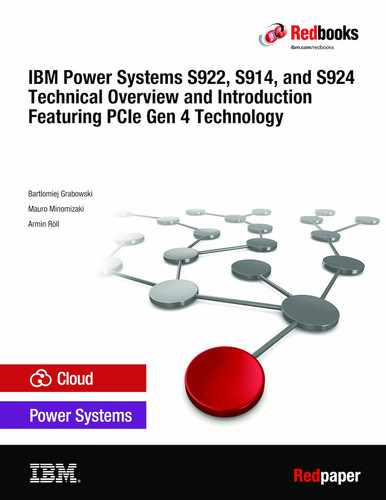This IBM® Redpaper publication is a comprehensive guide that covers the IBM Power System S914 (9009-41G), IBM Power System S922 (9009-22G), and IBM Power System S924 (9009-42G) servers that use the latest IBM POWER9™ processor-based technology and support the IBM AIX®, IBM i, and Linux operating systems (OSs). The goal of this paper is to provide a hardware architecture analysis and highlight the changes, new technologies, and major features that are being introduced in these systems, such as: This paper does not replace the current marketing materials and configuration tools. It is intended as an extra source of information that, together with existing sources, can be used to enhance your knowledge of IBM server solutions.
This publication is for professionals who want to acquire a better understanding of IBM Power Systems™ products. The intended audience includes the following roles:
This paper expands the current set of IBM Power Systems documentation by providing a desktop reference that offers a detailed technical description of the Power S914, Power S922, and Power S924 systems.
Table of Contents
- Front cover
- Notices
- Preface
- Chapter 1. IBM Power Systems S922, S914, and S924 overview
- 1.1 Systems overview
- 1.1.1 Power S922 server
- 1.1.2 Power S914 server
- 1.1.3 Power S924 server
- 1.1.4 Common features
- 1.2 Operating environment
- 1.3 Physical package
- 1.3.1 Tower model
- 1.3.2 Rack-mount model
- 1.4 System features
- 1.4.1 Power S922 server features
- 1.4.2 Power S914 server features
- 1.4.3 Power S924 server features
- 1.5 Minimum features
- 1.5.1 Power supply features
- 1.5.2 Processor module features
- 1.5.3 Memory features
- 1.5.4 Peripheral Component Interconnect Express slots
- 1.6 Disk and media features
- 1.7 I/O drawers for Power S922, Power S914, and Power S924 servers
- 1.7.1 PCIe Gen3 I/O expansion drawer
- 1.7.2 I/O drawers and usable PCI slots
- 1.7.3 EXP12SX SAS Storage Enclosure and EXP24SX SAS Storage Enclosure
- 1.8 IBM i Solution Editions for Power S914
- 1.9 IBM Capacity BackUp
- 1.9.1 Power S922 (9009-22G) IBM Capacity BackUp offering
- 1.9.2 Power S914 (9009-41G) IBM Capacity BackUp offering
- 1.9.3 Power S924 (9009-42G) IBM Capacity BackUp offering
- 1.10 IBM Power Systems Enterprise Cloud Edition
- 1.10.1 IBM PowerSC
- 1.10.2 IBM PowerSC Multi-Factor Authentication
- 1.10.3 IBM Cloud PowerVC Manager
- 1.10.4 IBM VM Recovery Manager DR
- 1.10.5 IBM Aspera High-Speed Transfer Endpoint 100 Mbps
- 1.10.6 IBM Cloud Management Console
- 1.11 IBM Power platform modernization
- 1.11.1 IBM Power Systems Virtual Servers
- 1.11.2 Red Hat OpenShift Container Platform for Power
- 1.12 System racks
- 1.12.1 IBM 7014 Model T00 rack
- 1.12.2 IBM 7014 Model T42 rack
- 1.12.3 IBM 42U Slim Rack 7965-94Y
- 1.12.4 1.8 Meter Rack (0551)
- 1.12.5 2.0 Meter Rack (#0553)
- 1.12.6 Rack (#ER05)
- 1.12.7 The AC power distribution unit and rack content
- 1.12.8 Rack-mounting rules
- 1.12.9 Useful rack additions
- 1.12.10 Original equipment manufacturer racks
- 1.13 Hardware Management Console
- 1.13.1 New features
- 1.13.2 Hardware Management Console overview
- 1.13.3 Hardware Management Console code level
- 1.13.4 Two architectures of Hardware Management Console
- 1.13.5 Virtual Hardware Management Console
- 1.13.6 Connectivity to POWER9 processor-based systems
- 1.13.7 High availability Hardware Management Console configuration
- 1.13.8 Flat panel display options
- Chapter 2. Architecture and technical overview
- 2.1 The IBM POWER9 processor
- 2.1.1 POWER9 processor overview
- 2.1.2 POWER9 processor features
- 2.1.3 POWER9 processor core
- 2.1.4 Simultaneous multithreading
- 2.1.5 Processor feature codes
- 2.1.6 Memory access
- 2.1.7 On-chip L3 cache innovation and intelligent caching
- 2.1.8 Hardware transactional memory
- 2.1.9 Coherent Accelerator Processor Interface 2.0
- 2.1.10 Power management and system performance
- 2.1.11 Comparing the POWER9, POWER8, and POWER7+ processors
- 2.2 Memory subsystem
- 2.2.1 Memory placement rules
- 2.2.2 Memory bandwidth
- 2.3 System buses
- 2.3.1 Memory buses
- 2.3.2 Inter-node SMP X-buses
- 2.3.3 PCIe Gen 4 buses
- 2.3.4 Service processor interface bus
- 2.4 Internal I/O subsystem
- 2.4.1 Slot configuration
- 2.4.2 System ports
- 2.5 Peripheral Component Interconnect adapters
- 2.5.1 Peripheral Component Interconnect Express
- 2.5.2 LAN adapters
- 2.5.3 Graphics accelerator adapters
- 2.5.4 SAS adapters
- 2.5.5 Fibre Channel adapters
- 2.5.6 InfiniBand host channel adapter
- 2.5.7 Cryptographic coprocessor
- 2.5.8 Coherent Accelerator Processor Interface adapters
- 2.5.9 USB adapters
- 2.5.10 Async adapter
- 2.6 Internal storage
- 2.6.1 9009-41G and 9009-42G Backplane (#EJ1C)
- 2.6.2 9009-41G and 9009-42G Split Backplane option for #EJ1C
- 2.6.3 9009-41G and 9009-42G Backplane (#EJ1D)
- 2.6.4 9009-41G and 9009-42G Expanded Function Backplane (#EJ1M)
- 2.6.5 9009-41G and 9009-42G Gen 4 Backplane (#EJ1S)
- 2.6.6 9009-22G Backplane (#EJ1F)
- 2.6.7 9009-22G Expanded Function Storage Backplane (#EJ1G)
- 2.6.8 NVMe support
- 2.6.9 RAID support
- 2.6.10 Easy Tier
- 2.6.11 External SAS ports
- 2.6.12 Media drawers
- 2.6.13 External DVD drives
- 2.6.14 RDX removable disk drives
- 2.7 External IO subsystems
- 2.7.1 Peripheral Component Interconnect Express Gen3 I/O expansion drawer
- 2.7.2 PCIe Gen3 I/O expansion drawer optical cabling
- 2.7.3 PCIe Gen3 I/O expansion drawer system power control network cabling
- 2.8 External disk subsystems
- 2.8.1 EXP12SX SAS Storage Enclosure and EXP24SX SAS Storage Enclosure
- 2.8.2 IBM Storage
- 2.9 Operating system support
- 2.9.1 AIX operating system
- 2.9.2 IBM i
- 2.9.3 Linux operating system
- 2.9.4 Virtual I/O Server
- 2.10 Power Systems reliability, availability, and serviceability capabilities
- 2.11 Manageability
- 2.11.1 Service user interfaces
- 2.11.2 Power Systems Firmware maintenance
- 2.11.3 Concurrent Firmware Maintenance improvements
- 2.11.4 IBM Electronic Services and IBM Electronic Service Agent
- Related publications
- Back cover
